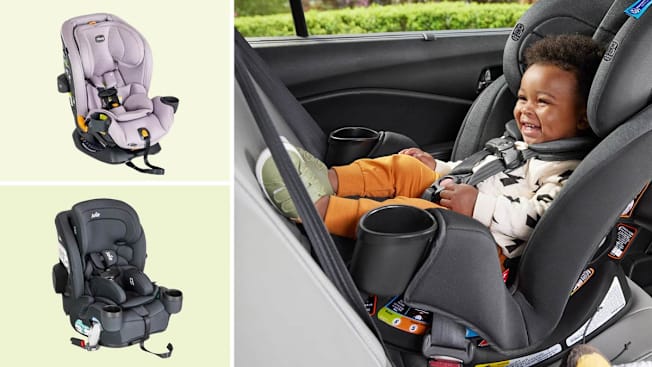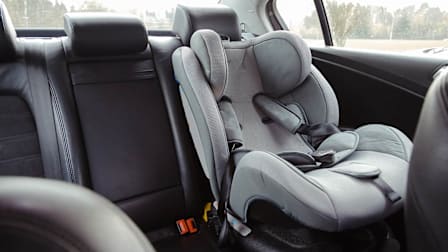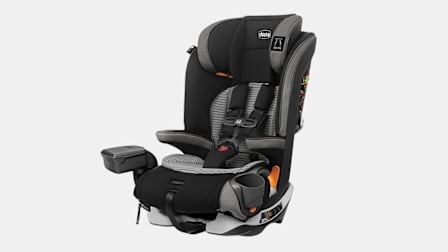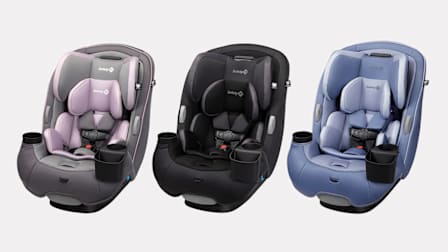5 Best All-in-One Car Seats of 2025, Lab-Tested and Reviewed
An all-in-one car seat can take your child from birth to booster-age. Here are our expert-recommended picks.
When you shop through retailer links on our site, we may earn affiliate commissions. 100% of the fees we collect are used to support our nonprofit mission. Learn more.
As the name implies, all-in-one car seats are meant to be an all-in-one solution: Rather than buying an infant car seat, then moving your child up to a convertible car seat and eventually a booster, all-in-one child seats are designed to take children from birth to booster-seat age. They can be an easy choice for families looking for both convenience and value.
5 Best All-in-One Car Seats
Based on CR’s rigorous evaluations, these all-in-one car seats stand out for their balance of crash protection, ease of use, vehicle fit when used as a harnessed seat, and seat belt fit in booster mode. Our crash protection ratings rank seats by the additional level of safety they may provide beyond the federal safety standards on a scale of Basic, Better, and Best.
When Should You Switch or Upgrade Your Car Seat?
Here’s how to safely transition from an infant car seat to a convertible or all-in-one car seat, and then to a belt-positioning booster seat.
How CR Tests All-in-One Car Seats
Every year, we independently crash-test child car seats at a certified testing lab to determine our crash protection ratings. Our staff of certified child passenger safety technicians (CPSTs) and engineers spend weeks analyzing each seat at our Auto Test Center for ease of use, installation, and how well each seat fits in a range of different vehicles, from sedans to SUVs to minivans. We buy every car seat we test—and never accept manufacturer samples. Here are the factors that we look at in our ratings.
Crash Protection
Using a proprietary simulated frontal crash test at 35 mph, we evaluate a car seat’s potential for providing an additional margin of safety that goes beyond the federal standard. Our scale ranks seats from those that offer the least to the most additional safety on a scale of Basic, Better, and Best.
Ease of Use
As our expert CPSTs like to say, the safest car seat is the one you can use properly every time—which means that a seat’s ease of use is a big factor in the level of safety it provides, too. In our tests, we examine every car seat’s manual, plus the labels, diagrams, and guides on the car seats themselves for clarity and thoroughness. For all-in-ones specifically, we look at how simple it is to transition between different modes of use. We also check how easy it is to adjust and tighten the harness clips and buckles, plus how heavy or bulky the seat is, which may be a factor if you’re regularly moving it between cars. We also assess any included features that might make installation easier, so you can get a tight fit each time.
Forward-Facing Fit to Vehicle With LATCH and Belt
How securely can you get a correct installation in forward-facing mode in the back seats of different types of cars? We check each car seat in a range of seating positions in a variety of different cars, and combine scores for both LATCH and seat belt installation to get our fit-to-vehicle rating.
Rear-Facing Fit to Vehicle With LATCH and Belt
Similarly, we test for a secure fit in rear-facing mode in a variety of positions in different cars’ back seats. Our testers combine the scores for both LATCH and seat belt installation in rear-facing mode for this metric.
Booster Fit
A booster seat is designed to correctly position a seat belt across a child’s chest and hips, but not all of them do a great job with this task. In addition, booster seats should fit snugly inside a vehicle’s back seat without bumping up against a headrest or vehicle seat bolsters. We look at the design elements for a safe and secure fit here, too.
We combine the results of these tests to determine the Overall Score. Car seats are ranked by how they perform in comparison with other car seats of the same type. CR’s dedicated car seat testing hub has more information about our testing standards and methods.
How to Buy a Safe Used Car
Here’s what to look for, plus used cars we love for their combination of safety and reliability.
Benefits of All-in-One Car Seats
Value: Recent tariffs on U.S. imports have increased the cost of baby gear like car seats, strollers, cribs, and high chairs, many of which are imported. Higher costs mean that purchasing just one seat rather than a new seat for each stage could save you money in the long run. Here’s an example: The average cost of the all-in-one seats in CR’s ratings is roughly $330, with the most expensive option being $750. “When compared with the average $868 combined cost of buying three individual seats [an infant car seat, a convertible car seat, and a booster seat], the value potential of buying a single all-in-one seat that can be used for all stages is clear,” says Emily A. Thomas, PhD, CR’s associate director of auto safety.
Familiarity: Properly using and securely installing your car seat can come with a steep learning curve. One advantage of an all-in-one is that as your child grows and transitions from rear-facing to forward-facing and harness to booster, the familiarity of the seat means you won’t need to relearn everything. There may be one or two new steps, but the basics will remain the same, and you can already be sure that the seat will fit in your vehicle’s back seat—no more geometry guessing games.
Sustainability: Buying just one seat instead of three separate seats is kinder to the environment, too, because there aren’t many car seat recycling programs. (Use our interactive tool to determine whether you can pass your used car seat on to another family.)
Downsides of All-in-One Car Seats
Weight and bulk: Because they’re designed to serve so many purposes, all-in-one car seats can be fairly heavy and bulky. They average around 22 pounds, and the heaviest seat in our ratings is 36 pounds. “The seat’s weight really comes into play in two main areas: LATCH usability and booster mode,” says Michael Bloch, child seat project leader, who helps lead CR’s car seat testing program.
The lower anchors in all vehicles can be used only up to 65 pounds total (which includes the weight of the child plus the weight of the car seat), so using a heavier car seat means you’ll need to switch to a seat belt installation sooner. And while most people aren’t moving their car seat between vehicles very often while their kids are in the harness stage, they’re more likely to move their booster between vehicles for play dates, sports practice, or school pickups. Lugging around a heavy all-in-one car seat adds a level of difficulty to any of those situations. A smart alternative is to have a more portable spare booster seat on hand for those occasions.
Convenience in the infant stage: A dedicated infant seat that includes a carrier with a handle is helpful for carrying your baby around more easily, transferring them to a flat sleeping surface if they’re dozing in the car seat, and connecting the car seat to a compatible stroller. You simply won’t get that convenience with an all-in-one car seat. These seats stay installed in the vehicle and don’t have a detachable carrier like infant car seats. They may also not come with an attached canopy, which can be helpful for blocking the sun from your infant’s face.
Upkeep and cleanliness: Most all-in-ones last for 10 to 12 years, which is a long time to use the same car seat. Many have machine-washable covers, but that’s still more than a decade’s worth of food crumbs, diaper explosions, spit-ups, and potty training accidents. Even the most conscientious parents may struggle with stubborn stains or smells.
Features and technology: Car seat safety technology and ease-of-use features continue to evolve. By the time your child is ready to use their all-in-one in booster mode, there may be newer features available or updated safety standards that you could miss out on.
When an All-in-One Car Seat May Work Best
As a second seat: “Although all-in-ones can be used for newborns, we think that the fit and carrier convenience provided by a dedicated infant car seat still make it your best bet,” says Thomas. She recommends that after your child outgrows their infant car seat, or preferably, by their first birthday, you can switch to an all-in-one instead of a traditional convertible car seat to keep your child rear-facing, then transition to forward-facing and ultimately a booster.
As a spare seat: All-in-ones can also be used as your safe alternate seat, perhaps to keep with the babysitter or installed in a grandparent’s car for occasional use.
FAQs About All-in-One Car Seats
What Is an All-in-One Car Seat?
An all-in-one car seat is a car seat that combines multiple modes in one: It can be used as an infant car seat, a rear-facing harnessed car seat, a forward-facing harnessed car seat, and a belt-positioning booster seat, with either a highback or no back (or both). All-in-ones are designed to grow with your child so that you can continue using the same car seat in different modes until the time your child is ready for the vehicle seat belt alone, typically once they reach the height of 4 foot, 9 inches or above. All-in-ones are designed to last for 10 to 12 years, and this longevity can make an all-in-one a cost-effective purchase for many families, rather than buying a new car seat every time your child needs to switch to a different stage. But given that these car seats are designed to “do it all,” they can be quite heavy and bulky, especially as your child reaches the booster stage, and they may not be a great fit for families who need to move their car seat between cars frequently.
What's the Difference Between an All-in-One Car Seat and a Convertible Car Seat?
Though these terms are often used interchangeably, there is a slight difference between an all-in-one car seat and a convertible car seat. Namely, an all-in-one car seat is designed to be used as a rear-facing car seat, a forward-facing car seat, and a booster seat, whereas a convertible car seat is designed to transition between rear-facing to forward-facing only: It doesn’t become a booster seat. Because of this, if you have a convertible car seat, you’ll need to purchase a separate booster seat once your child is ready for that stage. However, both all-in-one car seats and convertible car seats can be used as an infant car seat, as long as your baby meets the minimum weight requirement.
Should You Buy an Infant Car Seat or an All-in-One?
Though you can use an all-in-one car seat for your infant as long as they meet the minimum weight requirement, CR’s car seat experts recommend using a dedicated infant car seat for the first year of life (or until your baby outgrows the weight or height limit). Infant car seats are specially designed to protect infants from birth and may also have added conveniences for this stage, like a detachable base and carry handle that make it more portable for transport, stroller compatibility, and a canopy that can block the sun or wind. Although they’re less portable, all-in-one car seats can have a significantly longer lifespan, often lasting well into the school-age years.
Do All-in-One Car Seats Help Children Ride Rear-Facing for Longer?
Following the advice from the American Academy of Pediatrics (AAP) and National Highway Traffic Safety Administration, children should stay in a rear-facing car seat for as long as possible, until they reach the weight or height limit of the car seat. An all-in-one or convertible car seat has higher weight or height limits for the rear-facing mode than an infant car seat, which means you can keep your child rear-facing for longer. Many will have limits that allow children to stay rear-facing until age 2 and beyond, according to AAP. CR’s experts recommend that you switch from an infant car seat to a rear-facing all-in-one or convertible car seat by your child’s first birthday for added safety and protection.
How CR Tests Baby Gear
At CR, we hold baby gear to the highest standards—because nothing matters more than your child’s safety. Our testing is rigorous, independent, and free from outside influence. We buy everything we test, and we don’t accept advertising. Our nonprofit mission is to champion fairness, safety, and transparency, and to help every family make confident, informed decisions about the products they use. Support our efforts by becoming a member or donating to our mission today.


































































